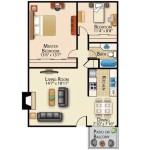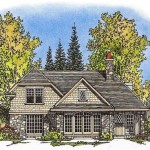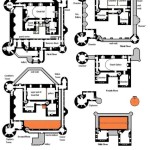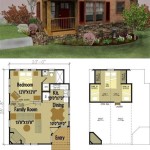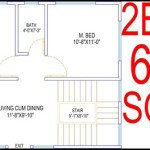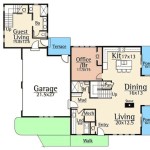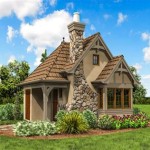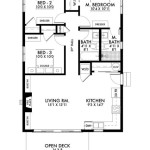2 Bedroom Guest House Floor Plans: Design Your Dream Getaways
The allure of a guest house extends beyond providing accommodation for visitors. It represents an opportunity to create a private retreat, an extension of the main residence that offers comfort, functionality, and a touch of personalized style. A well-designed 2-bedroom guest house floor plan is crucial for maximizing space, ensuring privacy for both hosts and guests, and enhancing the overall property value. This article will explore key considerations in designing such a space, focusing on layout options, essential features, and design elements that contribute to a successful and welcoming guest house environment.
The planning phase is paramount. It involves assessing the available space, considering the intended use of the guest house, and establishing a realistic budget. Understanding local building codes and regulations is also essential to avoid future complications. Factors like proximity to the main house, accessibility, and surrounding landscape will all influence the design process. A thorough assessment will lay the foundation for a functional and aesthetically pleasing guest house.
Optimizing Space and Layout
The key to a successful 2-bedroom guest house floor plan lies in efficient space utilization. Careful consideration of the layout will determine how comfortably the space accommodates guests and how seamlessly it integrates with the main residence. Several layout options exist, each with its own advantages and disadvantages.
A common approach is a linear layout, where rooms are arranged sequentially along a central corridor. This design is particularly suitable for narrower lots and allows for easy access to all areas. A variation of this is the open-plan layout, which merges the living, dining, and kitchen areas into a single, larger space. This creates a more spacious and social atmosphere, ideal for guests who enjoy interacting. However, it's crucial to delineate these zones using furniture arrangement, flooring changes, or subtle architectural features to maintain a sense of order and purpose.
Another option is a split-bedroom layout, where the bedrooms are located on opposite sides of the living area. This offers enhanced privacy for guests, particularly if they are unrelated or have different schedules. A central living area acts as a buffer, minimizing noise transfer between bedrooms. This layout is often preferred for guest houses intended for longer stays or those hosting multiple individuals.
Consider the orientation of the guest house when designing the layout. Positioning the main living areas to capture natural light and scenic views can significantly enhance the overall experience. Similarly, placing bedrooms away from direct sunlight can help maintain a cooler and more comfortable sleeping environment. Understanding the sun's path throughout the day will inform decisions about window placement and room arrangement.
Furthermore, incorporating storage solutions is critical, regardless of the chosen layout. Built-in wardrobes, shelving units, and under-bed storage can help maximize space and keep the guest house tidy. Consider incorporating storage areas for cleaning supplies and linens to ensure the guest house remains well-maintained. Effective storage solutions contribute to a more comfortable and organized stay for guests.
Essential Features and Amenities
Beyond the basic layout, the inclusion of specific features and amenities will significantly impact the usability and desirability of the guest house. These features should be carefully selected based on the intended use of the guest house and the preferences of the anticipated guests.
A fully functional kitchen is often considered essential, allowing guests to prepare their own meals and snacks. This includes a refrigerator, stove or cooktop, microwave, and sink. The size of the kitchen can vary depending on the available space and the expected level of cooking. A small kitchenette may suffice for shorter stays, while a larger, fully equipped kitchen is more suitable for longer-term guests.
A well-appointed bathroom is another critical feature. Consider including a shower, toilet, and vanity with ample storage. If space allows, a bathtub can provide an added luxury. Proper ventilation is essential to prevent moisture buildup and maintain a fresh and clean environment. Consider incorporating a window or exhaust fan to ensure adequate airflow.
Comfortable and functional furniture is crucial for creating a welcoming atmosphere. The bedrooms should include comfortable beds, bedside tables, and reading lamps. The living area should feature seating options, such as a sofa or armchairs, as well as a coffee table and television. Consider incorporating a dining table and chairs for meals. The furniture should be durable, easy to clean, and aesthetically pleasing.
Climate control is essential for maintaining a comfortable temperature throughout the year. This can be achieved through a central heating and air conditioning system or individual units in each room. Proper insulation is also crucial for minimizing energy consumption and maintaining consistent temperatures. Consider incorporating ceiling fans to enhance air circulation.
Finally, consider incorporating outdoor living spaces, such as a patio or deck. This provides guests with a space to relax and enjoy the surrounding environment. Outdoor furniture, such as chairs, tables, and umbrellas, can enhance the usability of these spaces. Consider adding landscaping to create a more private and aesthetically pleasing outdoor area.
Design Elements and Considerations
The aesthetic design of the guest house plays a significant role in creating a welcoming and comfortable environment. The choice of materials, colors, and finishes can significantly impact the overall atmosphere. Careful consideration of these elements will contribute to a guest house that is both functional and visually appealing.
The color palette should be carefully chosen to create a sense of calm and relaxation. Neutral colors, such as beige, gray, and white, are often preferred as they create a versatile backdrop that can be easily accented with pops of color. Consider incorporating natural elements, such as wood and stone, to add warmth and texture to the space. Avoid using overly bright or jarring colors, as these can be overwhelming and detract from the overall sense of tranquility.
Lighting is another crucial element of design. Natural light should be maximized through the use of large windows and skylights. Artificial lighting should be carefully planned to provide adequate illumination for all activities. Consider using a combination of ambient, task, and accent lighting to create a layered and dynamic effect. Dimmable lights can provide added flexibility, allowing guests to adjust the lighting to suit their needs.
Flooring materials should be durable, easy to clean, and aesthetically pleasing. Hardwood flooring is a popular choice, as it is both durable and visually appealing. Tile flooring is a good option for bathrooms and kitchens, as it is waterproof and easy to maintain. Carpet can add warmth and comfort to bedrooms and living areas. Consider using area rugs to define spaces and add visual interest.
Window treatments should be chosen to provide privacy, control light, and enhance the overall aesthetic. Curtains, blinds, and shades are all popular options. Consider using blackout curtains in bedrooms to block out light and ensure a good night's sleep. Sheer curtains can provide privacy while still allowing natural light to filter through.
Finally, consider incorporating personal touches to make the guest house feel more welcoming and inviting. This can include artwork, plants, or decorative items that reflect the personality of the host. Providing a welcome basket with snacks, drinks, and local information can also make guests feel more comfortable and appreciated. These small details can make a big difference in creating a memorable and enjoyable experience for guests.

Cottage House Plan With 2 Bedrooms And 1 5 Baths 5650

2 Bedroom Tiny House Floor Plans 650 Sq Ft Design

Small 2 Story House Plans And S Tiny Two Level Floor
Shouse Floor Plans House Free Designs

European Luxury House Plan 4525

Rustic Lake Style House Plan 3131 Sheridan Ii

Lake House Designs And More Blog Eplans Com

Four Bedroom Tiny Houses To Inspire Your Design The Life

Unique Octagonal Modern Style House Plan 8652

12 Modern A Frame Cabin Plans Homes Tiny Houses Craft
Related Posts

